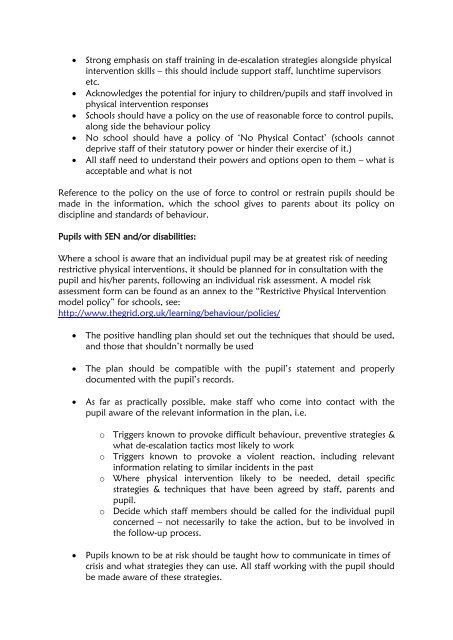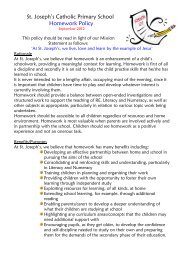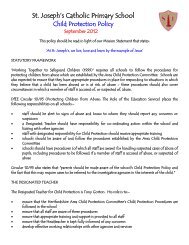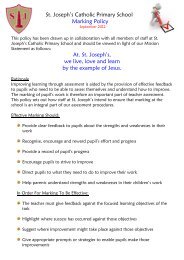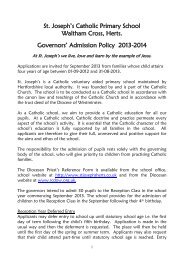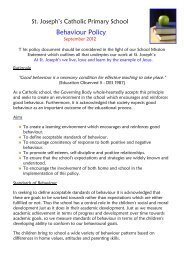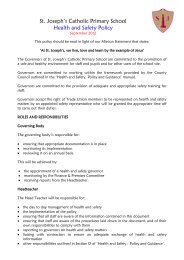hertfordshire's policy on physical intervention in schools
hertfordshire's policy on physical intervention in schools
hertfordshire's policy on physical intervention in schools
Create successful ePaper yourself
Turn your PDF publications into a flip-book with our unique Google optimized e-Paper software.
Str<strong>on</strong>g emphasis <strong>on</strong> staff tra<strong>in</strong><strong>in</strong>g <strong>in</strong> de-escalati<strong>on</strong> strategies al<strong>on</strong>gside <strong>physical</strong><br />
<strong>in</strong>terventi<strong>on</strong> skills – this should <strong>in</strong>clude support staff, lunchtime supervisors<br />
etc.<br />
Acknowledges the potential for <strong>in</strong>jury to children/pupils and staff <strong>in</strong>volved <strong>in</strong><br />
<strong>physical</strong> <strong>in</strong>terventi<strong>on</strong> resp<strong>on</strong>ses<br />
Schools should have a <str<strong>on</strong>g>policy</str<strong>on</strong>g> <strong>on</strong> the use of reas<strong>on</strong>able force to c<strong>on</strong>trol pupils,<br />
al<strong>on</strong>g side the behaviour <str<strong>on</strong>g>policy</str<strong>on</strong>g><br />
No school should have a <str<strong>on</strong>g>policy</str<strong>on</strong>g> of ‘No Physical C<strong>on</strong>tact’ (<strong>schools</strong> cannot<br />
deprive staff of their statutory power or h<strong>in</strong>der their exercise of it.)<br />
All staff need to understand their powers and opti<strong>on</strong>s open to them – what is<br />
acceptable and what is not<br />
Reference to the <str<strong>on</strong>g>policy</str<strong>on</strong>g> <strong>on</strong> the use of force to c<strong>on</strong>trol or restra<strong>in</strong> pupils should be<br />
made <strong>in</strong> the <strong>in</strong>formati<strong>on</strong>, which the school gives to parents about its <str<strong>on</strong>g>policy</str<strong>on</strong>g> <strong>on</strong><br />
discipl<strong>in</strong>e and standards of behaviour.<br />
Pupils with SEN and/or disabilities:<br />
Where a school is aware that an <strong>in</strong>dividual pupil may be at greatest risk of need<strong>in</strong>g<br />
restrictive <strong>physical</strong> <strong>in</strong>terventi<strong>on</strong>s, it should be planned for <strong>in</strong> c<strong>on</strong>sultati<strong>on</strong> with the<br />
pupil and his/her parents, follow<strong>in</strong>g an <strong>in</strong>dividual risk assessment. A model risk<br />
assessment form can be found as an annex to the “Restrictive Physical Interventi<strong>on</strong><br />
model <str<strong>on</strong>g>policy</str<strong>on</strong>g>” for <strong>schools</strong>, see:<br />
http://www.thegrid.org.uk/learn<strong>in</strong>g/behaviour/policies/<br />
<br />
<br />
<br />
The positive handl<strong>in</strong>g plan should set out the techniques that should be used,<br />
and those that shouldn’t normally be used<br />
The plan should be compatible with the pupil’s statement and properly<br />
documented with the pupil’s records.<br />
As far as practically possible, make staff who come <strong>in</strong>to c<strong>on</strong>tact with the<br />
pupil aware of the relevant <strong>in</strong>formati<strong>on</strong> <strong>in</strong> the plan, i.e.<br />
o Triggers known to provoke difficult behaviour, preventive strategies &<br />
what de-escalati<strong>on</strong> tactics most likely to work<br />
o Triggers known to provoke a violent reacti<strong>on</strong>, <strong>in</strong>clud<strong>in</strong>g relevant<br />
<strong>in</strong>formati<strong>on</strong> relat<strong>in</strong>g to similar <strong>in</strong>cidents <strong>in</strong> the past<br />
o Where <strong>physical</strong> <strong>in</strong>terventi<strong>on</strong> likely to be needed, detail specific<br />
strategies & techniques that have been agreed by staff, parents and<br />
pupil.<br />
o Decide which staff members should be called for the <strong>in</strong>dividual pupil<br />
c<strong>on</strong>cerned – not necessarily to take the acti<strong>on</strong>, but to be <strong>in</strong>volved <strong>in</strong><br />
the follow-up process.<br />
<br />
Pupils known to be at risk should be taught how to communicate <strong>in</strong> times of<br />
crisis and what strategies they can use. All staff work<strong>in</strong>g with the pupil should<br />
be made aware of these strategies.


